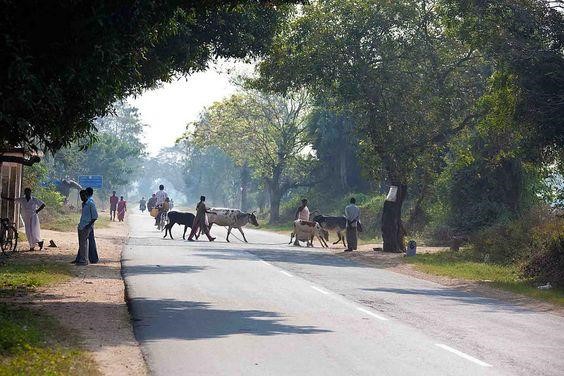Road infrastructure is an essential component of a country’s economy. It plays a crucial role in connecting people and communities, facilitating the movement of goods and services, and promoting economic growth. In rural areas, village roads are especially important as they provide access to essential healthcare, education, and markets.
A well-developed road network in rural areas can significantly impact the residents’ standard of living. It helps farmers transport their produce to markets, increasing their income and livelihoods. It also enables students to attend schools, patients to reach hospitals, and communities to access essential services.
However, in many rural areas, the road infrastructure needs to be improved, and the roads often need to be in better condition. It can lead to increased travel time, higher transport costs, and reduced access to essential services. In some cases, people living in remote areas may be cut off entirely from the rest of the world due to poor road connectivity.

Source: Pinterest
See also: Village house designs to take inspiration from
Village road: Construction
The construction of a village road involves several steps, including planning, design, procurement of materials and labour, construction, and maintenance. The following is a general overview of these steps:
- Planning: This stage involves determining the road construction project’s purpose and goals, assessing the community’s needs, and identifying potential funding sources.
- Design: This stage involves creating a detailed plan for the road construction project. The design should take into account the topography of the area, the traffic volume, and the drainage requirements.
- Procurement of materials and labour: This stage involves acquiring the necessary materials and hiring the labour required to construct the road. It may include asphalt, concrete, excavation equipment, and workers.
- Construction: This stage involves building the road. It may include excavation, grading, laying the road base, laying the asphalt or concrete surface, and installing drainage features.
- Maintenance: This stage involves regular road inspections to ensure that it remains in good condition and is safe for use. It may include patching potholes, repairing cracks, and replacing damaged road sections.
It is important to ensure that the construction of the village road meets all relevant standards and regulations to ensure its safety and longevity.
Village road: Benefits
Village roads have several benefits, including:
- Improved accessibility: Village roads provide better access to essential services such as healthcare, education, and markets. This improved accessibility increases economic opportunities and enhances the quality of life for villagers.
- Enhanced economic development: Good road infrastructure helps transport goods and services, promoting trade and commerce. It, in turn, drives economic growth and job creation in the region.
- Better connectivity: Village roads connect the villages to larger cities and towns, making it easier for people to travel for work, education, or medical treatment.
- Boosted tourism: Improved road access to rural areas can also boost tourism, as tourists can more easily reach rural destinations and experience the local culture and natural beauty.
- Increased agricultural productivity: Good roads make it easier for farmers to transport their crops to markets, reducing spoilage and increasing their incomes.
- Improved emergency services: Village roads provide easier access to emergency services such as ambulances and fire engines, which can help save lives in accidents or natural disasters.
- Enhanced quality of life: Good roads improve the overall quality of life in villages by making it easier to access essential services, reducing travel time and costs, and providing better connectivity to the outside world.
Overall, village roads play a crucial role in developing rural communities, helping reduce poverty, and improving living standards for those who live there.
Village road: Challenges in development and maintenance
Developing and maintaining village roads can be challenging for several reasons:
- Funding: Village roads are often located in rural areas and therefore need proper government financing. It can be challenging to secure funds for road development and maintenance.
- Lack of resources: Villages often need more resources and a workforce to develop and maintain their roads. It can include equipment, materials, and skilled workers.
- Lack of technical expertise: Developing and maintaining roads requires specialised technical skills and knowledge, often needing improvement in rural communities.
- Natural disasters: Village roads are often located in areas prone to natural disasters such as floods, landslides, and earthquakes. These disasters can damage roads and make it difficult to maintain them.
- Maintenance: The ongoing maintenance of roads is essential, but it can be challenging to coordinate and fund regular upkeep in rural areas.
- Limited access: Village roads are often isolated and difficult to access, which can make it challenging to transport construction materials, equipment, and workers to the site.
- Community involvement: Encouraging local communities to participate in the development and maintenance of their roads is important for sustainability, but it can be challenging to mobilise rural communities to take action.
Village road: Best practices for development and maintenance
Developing and maintaining village roads can be a challenging task, but following these best practices can help ensure that they are functional, safe, and sustainable:
- Plan and design: Develop a comprehensive plan for the road network that considers factors such as traffic volume, topography, and the local community’s needs.
- Material selection: Choose the right construction materials for the road surface, taking into account factors such as cost, availability, and durability. In rural areas, gravel or crushed stone is often used.
- Drainage: Proper drainage is essential to prevent water from damaging the road surface and making it difficult for vehicles to travel. Ensure the road has good drainage features, such as ditches and culverts, to channel water away from the road.
- Regular maintenance: Regular maintenance is crucial for keeping roads in good condition. It includes filling potholes, grading the road surface, and clearing vegetation that may grow on or near the road.
- Monitoring and evaluation: Regular monitoring and evaluation of the road network can help identify areas that need improvement or repair. It can also track progress and make informed decisions about future maintenance and development work.
- Involve the community: Involve the local community in developing and maintaining village roads. It helps ensure that their needs and concerns are accounted for and helps build a sense of ownership and responsibility for the road network.
- Collaborate with local government: Collaborating with local government can help ensure that the development and maintenance of village roads are in line with regional and national plans and policies. It can also help secure funding and support for the road network.
By following these best practices, you can help ensure that village roads are functional, safe, and sustainable and meet the local community’s needs.
FAQs
What is the purpose of building village roads?
The purpose of building village roads is to provide access to remote or isolated communities, improve connectivity and transportation, increase economic development, and improve living standards for residents.
Who is responsible for maintaining village roads?
The local government or community members typically maintain village roads. In some cases, the maintenance may also be carried out by NGOs or private organisations.
What types of materials are used to construct village roads?
The type of material used to construct village roads depends on various factors such as the terrain, climate, and available resources. Common materials include gravel, asphalt, concrete, and dirt.
What are the challenges faced while building village roads?
While building village roads, some challenges include lack of funding, difficulty accessing remote areas, challenging terrain, and limited equipment and workforce.
How does the lack of proper village roads affect the local community?
The lack of proper village roads affects the local community by hindering access to essential services such as healthcare, education, and markets. It also affects the ability to transport goods and products, leading to a decline in economic development.
| Got any questions or point of view on our article? We would love to hear from you.
Write to our Editor-in-Chief Jhumur Ghosh at jhumur.ghosh1@housing.com |
Housing News Desk is the news desk of leading online real estate portal, Housing.com. Housing News Desk focuses on a variety of topics such as real estate laws, taxes, current news, property trends, home loans, rentals, décor, green homes, home improvement, etc. The main objective of the news desk, is to cover the real estate sector from the perspective of providing information that is useful to the end-user.
Facebook: https://www.facebook.com/housing.com/
Twitter: https://twitter.com/Housing
Email: editor@housing.com











